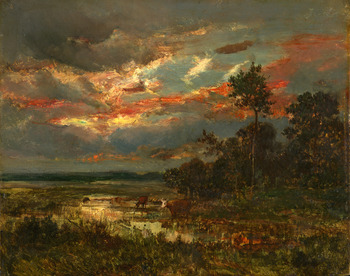Pierre Étienne Théodore Rousseau
Rousseau was born on April 15, 1812. His father and mother had a successful draper?s business in Paris, and among their relatives were several artists, chief among them Theodore?s cousin Alexandre Pau de Saint-Martin, a landscape painter. Rousseau began painting with his cousin at an early age, and when only fourteen years old was already studying professionally with the painter Remond. More important than these early studies, though, were his habit of copying after Claude and the Dutch masters and, above all, his early penchant for painting directly from nature. He made long painting excursions into the environs of Paris, including Fontainebleau, from 1826 to 1829. In 1830 he marked the end of all formal study (he had worked for a while with Guillion Lethiere) by a lengthy stay in the Auvergne, where he painted astonishing studies from nature, which have a remarkable liberty and intensity. Upon his return to Paris, his Byronic paintings attracted the noted painter, Ary Scheffer, through whom Rousseau soon became known to progressive circles in Paris. He appeared regularly in the Salon from 1831 to 1836, and rapidly became the most controversial figure in landscape, occupying a position analogous to that of Delacroix. His works were purchased by the Duc d?Orleans, and championed by the young Romantics led by Gautier and Borel. By 1834 he had associated himself with Charles Jacque, Jules Dupré, Honoré Daumier, Auguste Preault, Théophile Thoré, and others known for their radical politics. He was not a militant by nature, but he remained faithful to the Republican credo for the rest of his life.
During the 1830?s Rousseau traveled extensively throughout France, preferring the rather savage sites of the Auvergne, the Jura, and the then primitive sections of Fontainebleau forest. Following the lead of his friend Jules Dupré, he journeyed to more placid regions in the 1840?s, especially to the Landes near Bordeaux and to Berry. The emotional canvases of the 1830?s were now accompanied by more straightforward paintings of nature. He was excluded from the Salon from 1837 to 1847, and only with great difficulty managed to sell enough to live by, despite the friendship of Delacroix, George Sand, and others. He returned to the Salon in 1849 (he could have exhibited the previous year but had nothing ready) with three paintings in his more Romantic manner, and affirmed his reputation as the most important landscape painter of the July monarchy. He won a first-class medal from the liberal jury, enough to insure a rise to respectability, which lasted several years.
Rousseau had always worked regularly in the forest of Fountainebleau, but about 1837 he began to rent a studio in Barbizon nearly every year, and soon settled there on a permanent basis. His friendship with Jules Dupré, broken in 1849, was replaced with the closest association of his life, with Jean-François Millet. He traveled less often after the mid-century (his only ventures outside France were to cross the border into Switzerland). His winter quarters in Paris, and his summer studio in Barbizon were the preferred gathering places for the Barbizon artists, for whom Rousseau was the guiding spirit. In 1867, he won singular honors in the Universal Exhibition, but they came too late. He died in Millet?s arms on December 22, 1867, at the age of 55, the one man more than any other around whom the battle over landscape had been waged since 1830.
Selected Museum Collections:
Musée du Louvre and Musée d?Orsay, Paris; National Gallery and Wallace Collection, London, Metropolitan Museum and Frick Collection, New York; National Gallery of Art, Washington DC; Rijksmuseum, Amsterdam; Museum of Fine Arts, Boston; Art Institute of Chicago; J. Paul Getty Museum, Los Angeles; Thyssen-Bornemisza Museum, Madrid; Philadelphia Museum of Art; Hermitage Museum, Saint Petersburg; Fine Arts Museums of San Francisco; Clark Art Institute, Williamstown, MA;













